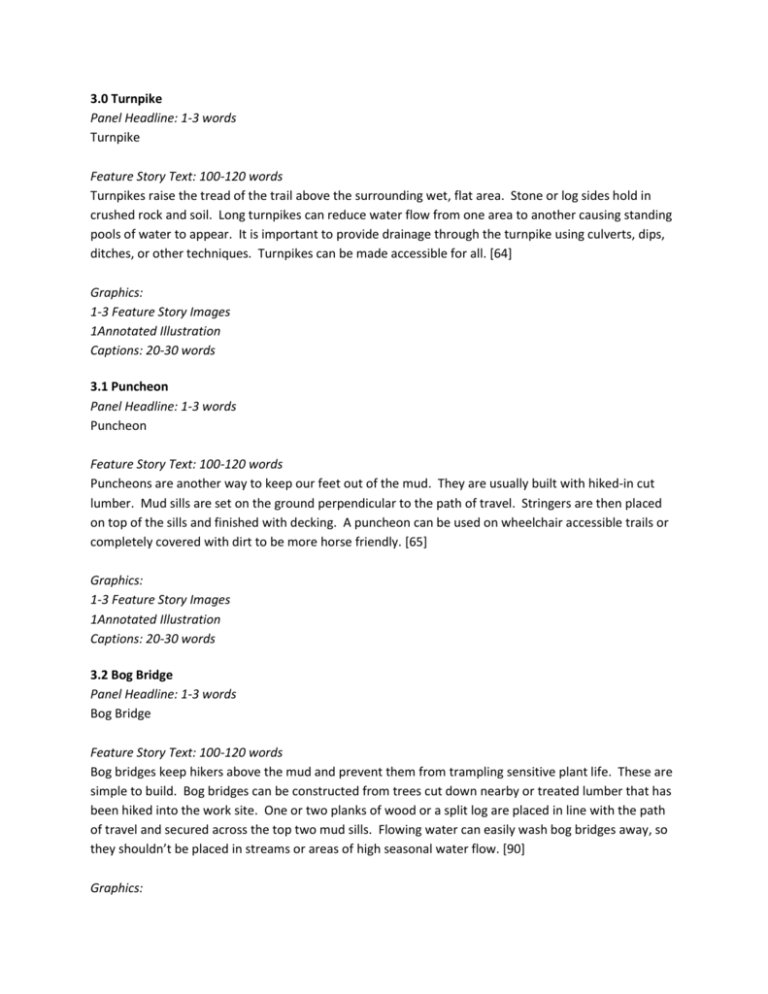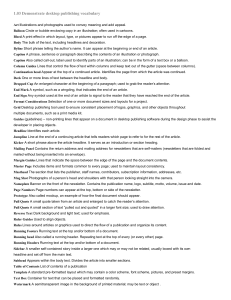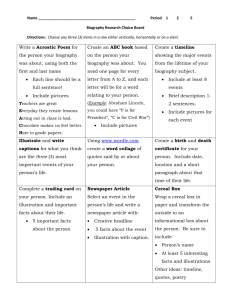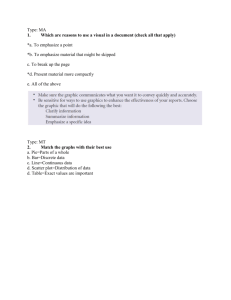3.0 Turnpike Panel Headline: 1-3 words Turnpike Feature Story Text
advertisement

3.0 Turnpike Panel Headline: 1-3 words Turnpike Feature Story Text: 100-120 words Turnpikes raise the tread of the trail above the surrounding wet, flat area. Stone or log sides hold in crushed rock and soil. Long turnpikes can reduce water flow from one area to another causing standing pools of water to appear. It is important to provide drainage through the turnpike using culverts, dips, ditches, or other techniques. Turnpikes can be made accessible for all. [64] Graphics: 1-3 Feature Story Images 1Annotated Illustration Captions: 20-30 words 3.1 Puncheon Panel Headline: 1-3 words Puncheon Feature Story Text: 100-120 words Puncheons are another way to keep our feet out of the mud. They are usually built with hiked-in cut lumber. Mud sills are set on the ground perpendicular to the path of travel. Stringers are then placed on top of the sills and finished with decking. A puncheon can be used on wheelchair accessible trails or completely covered with dirt to be more horse friendly. [65] Graphics: 1-3 Feature Story Images 1Annotated Illustration Captions: 20-30 words 3.2 Bog Bridge Panel Headline: 1-3 words Bog Bridge Feature Story Text: 100-120 words Bog bridges keep hikers above the mud and prevent them from trampling sensitive plant life. These are simple to build. Bog bridges can be constructed from trees cut down nearby or treated lumber that has been hiked into the work site. One or two planks of wood or a split log are placed in line with the path of travel and secured across the top two mud sills. Flowing water can easily wash bog bridges away, so they shouldn’t be placed in streams or areas of high seasonal water flow. [90] Graphics: 1-3 Feature Story Images 1Annotated Illustration Captions: 20-30 words 3.3 Corduroy Panel Headline: 1-3 words Corduroy Feature Story Text: 100-120 words Corduroy is a technique that has been in use since 4000BC. Logs are laid perpendicular to the direction of travel in low swampy areas to keep the tread passable. The bumpy surface can prove hazardous to users, especially horses, but can be covered with dirt or gravel to create a smoother, safer tread way. Corduroy roads were used by loggers throughout the United States, especially in Maine and the Pacific Northwest, to help transport timber through muddy areas. If the logs are completely buried in a wet area, it will take them a very long time to decay and rot. Corduroy roads dating back to the early 20th century can still be found in the United States. [117] Graphics: 1-3 Feature Story Images 1Annotated Illustration Captions: 20-30 words 3.4 Stepping Stones Panel Headline: 1-3 words Stepping Stones Feature Story Text: 100-120 words Stepping stones are large rocks with a flat surface to walk across. They allow us to walk over streams and muddy areas without getting wet and dirty. A suitable stepping stone weighs at least 200 pounds. If the stones are not big enough nor properly set in the ground, they can wobble, be washed away by a stream, or even worse – people won’t use them. In muddy areas where rocks are not available, log “cookies” can also be used. [79] Graphics: 1-3 Feature Story Images 1Annotated Illustration Captions: 20-30 words 3.5 Open Culvert Panel Headline: 1-3 words Open Culvert Feature Story Text: 100-120 words Open culverts create a channel for small streams to pass through the trail tread. They are easy to step over but cannot handle large amounts of water. Slabs of stone create the bottom and sides of the culvert and won’t wash away or move like dirt. Unlike the closed culverts most people are more familiar with, open culverts are easy to keep clear of debris. Both open and closed culverts made entirely of stone can be found on the Appalachian Trail on Bear Mountain. Look for them while you hike! [90] Graphics: 1-3 Feature Story Images 1Annotated Illustration Captions: 20-30 words 3.6 Bridge Panel Headline: 1-3 words Bridge Feature Story Text: 100-120 words Bridges allow us to cross very muddy areas, flowing water, and dangerous areas such as steep valleys and roads while remaining clean, dry, and safe. Bridges come in every shape and size and are made out of many different materials. Many bridges on trails are built from trees cut down nearby. Once the best placement for a bridge is determined, abutments set the bridge upon are built if needed. Trees are cut down, branches and bark taken off, and the logs are placed across the stream, either by the work of many hands or the help of rigging and high lines. Once the logs are secured, decking and railings are added. [111] Graphics: 1-3 Feature Story Images 1Annotated Illustration Captions: 20-30 words 3.7 Climbing Turn Panel Headline: 1-3 words Climbing Turns Feature Story Text: 100-120 words Climbing turns are a way to reduce the steepness of a trail, making it less likely that water will get trapped on the path and create a gully. Instead of building trails from the bottom of a mountain straight to the top, climbing turns can make things more interesting by taking you to a beautiful place you might not have seen otherwise. Rather than an abrupt turn, such as a switch back, climbing turns create a large radius turn that slows down users instead of making them come to a complete stop. Slower traffic means less displacement of soil from the trail tread and a safer experience, especially on multi-use trails. [111] Graphics: 1-3 Feature Story Images 1Annotated Illustration Captions: 20-30 words 3.8 Step Stile Panel Headline: 1-3 words Step Stile Feature Story Text: 100-120 words A step stile is one way to allow people passage over a wall or fence while keeping animals in. Stiles come in many form: wooden ladders built into or over fences, narrow gaps in fences and stone walls, and stairs like these built into stone walls. On the Appalachian Trail you will find step stiles where the trail passes through farmers’ fields. They make it relatively easy for people to climb up and over the boundary but impossible for animals to travel through that point. Stiles are also used to allow passage over historic walls while not destroying the structure. [100] Graphics: 1-3 Feature Story Images 1Annotated Illustration Captions: 20-30 words 3.9 Crib Wall Panel Headline: 1-3 words Crib Wall Feature Story Text: 100-120 words Commonly referred to as retaining wall, crib wall is a trail-building term for a wall built to hold up the tread of a trail. Crib wall can be constructed from wooden logs or stone. Dry stone crib are held together by gravity and friction and can last for centuries. On the Appalachian Trail on Bear Mountain there are thousands of square feet of crib wall built to provide tread to walk on across the steep rock slopes. When you are hiking up the trail, look at the downhill edge – all of those stone walls were built by volunteers led by trail-building professionals. [102] Graphics: 1-3 Feature Story Images 1Annotated Illustration Captions: 20-30 words 3.10 Rock Splitting Panel Headline: 1-3 words Rock Splitting Feature Story Text: 100-120 words A lot of rocks were needed to build the Appalachian Trail on Bear Mountain, but rocks don’t always naturally come in the size or shape for the job. So trail builders used the ancient art and science of splitting stone to size with feathers and wedges. First, the rock is examined for cracks, fissures, grain, and cleavage planes to determine how it will split best. Next, holes are drilled every four to six inches in line along the desired split. Lastly, feathers and wedges are inserted for hammering. The wedges are hammered one at a time, keeping them at the same resistance against the feathers and rock. The wedges increase in pitch like a xylophone as the split nears, until finally there is a “snap, crackle, pop,” and one rock becomes two. [132] Graphics: 1-3 Feature Story Images 1Annotated Illustration Captions: 20-30 words 3.11 Habitat Restoration Panel Headline: 1-3 words Stay on Trail! Feature Story Text: 100-120 words Feet can cause a lot of damage! Especially if many feet walk across the same areas over and over again. Feet compress the soil, making it harder for roots to get the rain water and oxygen they need. As a result, sediment can make its way into streams and rivers affecting fish habitat. This area is in the process of having plant life restored in an effort to protect the Hudson River. Please stay on the trail, which is built to withstand the many feet that come to Bear Mountain. In doing so, you can help preserve this beautiful park for future generations to enjoy. [105] Graphics: 1-3 Feature Story Images 1Annotated Illustration Captions: 20-30 words






